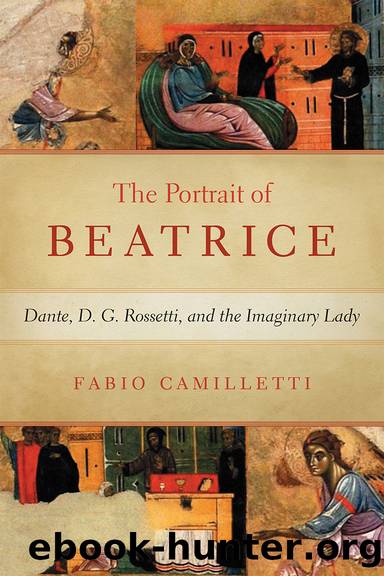Portrait of Beatrice by Fabio Camilletti

Author:Fabio Camilletti
Language: eng
Format: epub
Publisher: University of Notre Dame Press
Published: 2019-03-11T00:00:00+00:00
Chiaro dell’Erma’s Figura mistica is, in all respects, an icon: born out of an experience of vision, it aims precisely to represent the unrepresentable, so that its surface acts as a medium between the beholder and something that lies beyond the icon (its “model”). At the same time, its role is not uniquely confined to representing its model: in acknowledging that “the model that the picture depicts precedes the image,” John of Damascus—and the Byzantine culture of icons—nonetheless recognized that “in the process of our grasping what is represented in the image, the picture comes to enjoy an autonomy of sorts.”31 In such a process, Barasch writes, the icon comes to possess a power “in itself”: “There is an inherent affinity, an identity of sorts, between the representation and what it represents,” so that “the image itself is . . . a presence of what is reflected in it.”32
Consequently, the icon remains in a sense inaccessible to verbalization, and actually the entirety of “Hand and Soul” displays a symptomatic mistrust of all direct and graspable relationships between signifiers and signified things, and in particular of verbal articulations. Chiaro’s plan of painting allegories of civil virtues results in “cold and unemphatic” artworks, which his fellows citizens are unable (or unwilling) to decode. The catalog is unable to say anything about the Figura mistica, and indeed the adjective mistico is in itself nothing but a label that can be indiscriminately applied to whatever lies beyond understanding. Through a multilingual conversation that forms the end of the tale, Rossetti voices the reciprocal inability to communicate between Western art, born out of the Renaissance—whose stance is tellingly expressed by a French student—and the pre-Renaissance, medieval, and “Greek” evaluation of vision as a privileged channel for artistic inspiration, which only the Anglo-Italian narrator (who speaks perfect Italian and understands dialects) can understand. Perhaps a mixed origin and cultural uprootedness are the only prerequisites for escaping both the British penchant for irony (according to which the painting is merely “odd”) and the Italian propensity for laughter, both forms, in their own way, of a refusal to understand:
“Very odd, is it not?” said he. The other students near us were all continental; and seeing an Englishman select an Englishman to speak with, conceived, I suppose, that he could understand no language but his own. They had evidently been noticing the interest which the little picture appeared to excite in me. One of them, an Italian, said something to another who stood next to him. He spoke with a Genoese accent, and I lost the sense in the villainous dialect. “Che so?” replied the other, lifting his eyebrows towards the figure; “roba mistica: ‘st’ Inglesi son matti sul misticismo: somiglia alle nebbie di là. Li fa pensare alla patria, ‘E intenerisce il core / Lo di ch’han detto ai dolci amici adio’” [No idea. Mystical stuff. These Englishmen go crazy for mysticism: it resembles the mists of their country. Makes them think of their homeland, “and softens their hearts, on the day / they have said farewell to their sweet friends”].
Download
This site does not store any files on its server. We only index and link to content provided by other sites. Please contact the content providers to delete copyright contents if any and email us, we'll remove relevant links or contents immediately.
4 3 2 1: A Novel by Paul Auster(11032)
The handmaid's tale by Margaret Atwood(6836)
Giovanni's Room by James Baldwin(5870)
Big Magic: Creative Living Beyond Fear by Elizabeth Gilbert(4717)
Asking the Right Questions: A Guide to Critical Thinking by M. Neil Browne & Stuart M. Keeley(4564)
On Writing A Memoir of the Craft by Stephen King(4204)
Ego Is the Enemy by Ryan Holiday(3982)
Ken Follett - World without end by Ken Follett(3968)
The Body: A Guide for Occupants by Bill Bryson(3789)
Bluets by Maggie Nelson(3704)
Adulting by Kelly Williams Brown(3663)
Guilty Pleasures by Laurell K Hamilton(3578)
Eat That Frog! by Brian Tracy(3505)
White Noise - A Novel by Don DeLillo(3429)
The Poetry of Pablo Neruda by Pablo Neruda(3358)
Alive: The Story of the Andes Survivors by Piers Paul Read(3302)
The Bookshop by Penelope Fitzgerald(3220)
The Book of Joy by Dalai Lama(3212)
Fingerprints of the Gods by Graham Hancock(3206)
